![]()
Cambodia Travel Notes - Part 2 (Tuol Sleng)
According to the Khmer dictionary published by the Khmer Buddhist Institute in 1967, the word "Tuol" is a noun. It means the ground that is higher in level than that around it. The word "Sleng" can be a noun and also an adjective. When the word "Sleng" functions are an adjective, it means "supplying guilt" (del aoy tos) or "bearing poison" (del noam aoy mean toas) or "enemy of disease" (del chea sat-trov ning rok). As a noun, "Sleng" means the two kinds of indigenous Khmer poisonous trees. The first kind is "Sleng Thom" or "Big Sleng" that has a big trunk, leaves and fruit. The second type is "Sleng Vour" or "Sleng Vine" which is shaped almost like a vine with small fruit. They are both poisonous. Therefore, from the above translation we can see that Tuol Sleng literally means a poisonous hill or a place on a mound to keep those who bear or supply guilt.
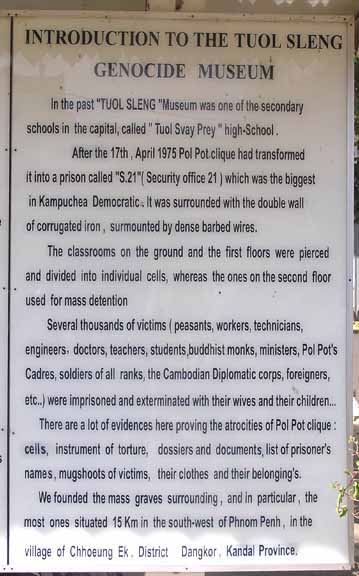
From David Chandler's Voices From S-21: Terror and History in Pol Pot's Secret Prison:
I first visited Tuol Sleng for less than an hour in August 1981. Since 1990, I have returned to the museum many times. In spite or perhaps because of the courtesy and friendliness of the staff, I am always disoriented between the peaceful, sun-soaked compound and the horrific exhibits on display, between the white-washed classrooms with their yellow and white tile floors and the instruments of torture they contain, between the children at play outside the buildings and the mug shots of other children en route to being killed.
...
On most of my visits mynay birds have hopped along the overgrown paths. Roosters have crowed around the neighborhood, the sound competing with the traffic on Monivong Boulevard to the east or, in the dry season, with music broadcast over loudspeakers from Buddhist wedding celebrations nearby.
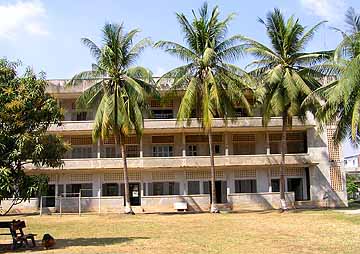

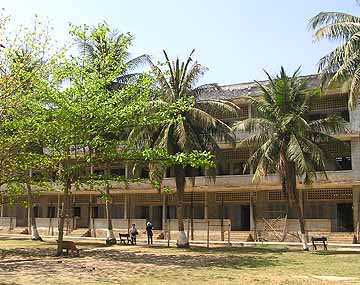
From David Chandler's Voices From S-21: Terror and History in Pol Pot's Secret Prison:
On January 8 [1979], in the southern sector of Tuol Svay Prey, two Vietnamese photographers who had accompanied the invasion were drawn toward a particular compound by the smell of decomposing bodies. The silent, malodorous site was surrounded by a corrugated tin fence topped with coils of barbed wire. Over the gate was a red placard inscribed in yellow with a Khmer slogan: "Fortify the spirit of the revolution! Be on your guard against the strategy and tactics of the enemy so as to defend the country, the people and the Party." The place carried no other identification.
Pushing inside, the two photographers found themselves on the grounds of what appeared once to have been a high school. The spacious, dilipidated compound measured roughly four hundred meters from east to west and six hundred meters from north to south. It consisted of four whitewashed concrete buildings, each three stories high, with balcony corridors running alongside each upper story. A fifth single story wooden building, facing west, split the compound into two identical grassy spaces. To the rear of each of these, one of the taller buildings faced east, toward the entrance. Similar buildings marked the northern and southern boundaries of the compound. The purpose of the compound was unclear to the two men, although the single-story building, littered with papers and office equipment, had obviously been used for some sort of administration.
In rooms on the ground floor of the southernmost building, the two Vietnamese came across the corpses of several recently murdered men. Some of the bodies were chained to iron beds. The prisoners' throats had been cut. The blood on the floor was still wet. Altogether the bodies of fourteen people were discovered in the compound, apparently killed only a couple of days before.
In large classrooms on the upper floors of the western buildings, the patrol found heaps of shackles, handcuffs, whips and lengths of chain. Other rooms on the upper floors had been divided by clumsily bricked partitions into small cells where each prisoner's foot had been manacled, as William Shawcross later wrote, "to a shackle alrge enough to take a ship's anchor." Ammunition boxes in some of the cells contained human feces. On the third floor were slightly larger, more elaborately constructed cells with wooden walls and doors.
The two intruders took photographs of all the rooms in the facility, adding photos of the corpses. They then informed the Vietnamese authorities of what they had found. That evening the corposes were incinerated as a sanitary measure. Some of the photographs taken at that time now hang in the rooms where the bodies were found.

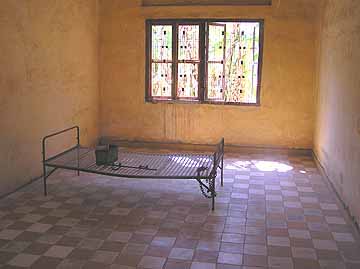
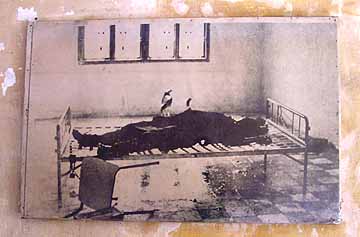
The details are not clear in the photo, but there was a knife plunged right into the heart.

Why the interest in a ceiling? Speckles of human blood are still visible even now.
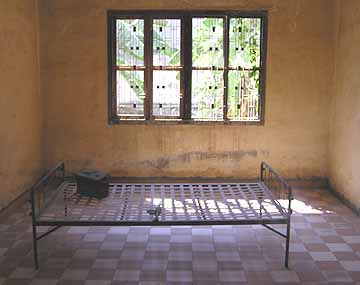






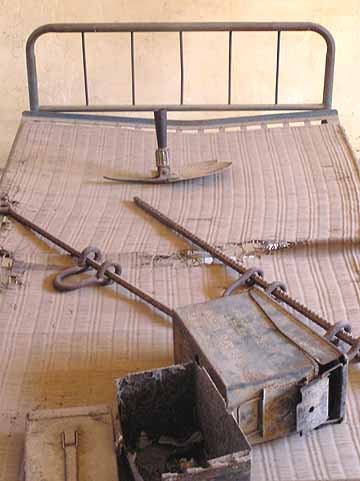

From David Chandler's Voices From S-21: Terror and History in Pol Pot's Secret Prison on the confession of the Thong Vann, a Party member arrested in September 1977:
When I first arrived [at S-21] a representative of the security office came and questioned me. He accused me of being CIA on the basis of the accusations of others who said that I was CIA. At that point I lost mastery completely and I said, "Negative." He said, "If [you say] 'negative' [there would be] a beating [that] would lead to our getting clear information."
TO start off with, I wrote a detailed summary of my revolutionary activities to date. When I had written it, the representative of the security office said, "How come I don't see any treacherous story [here]?"
"Because I've done no treacherous activities," I replied.
And the representative said, "If your answer is negative, you will be beaten." I asked if I could write the truth.
"If you write about treacherous activities, that would be good."
I knew that I could not withstand torture, so I decided to write a made-up story about my treasonous activities. I wrote that I had been a traitor since 1970 and about my connections with Non Suon when were were together in ... Oural.
I listed all the comrades who had carried out revolutionary activities with me in 1976. AFter I did this the security representative asked me to clarify my story: "What about treasonous activities when you were in the city?" he said.
I answered: "[There were] none."
The security representative said, "If you say 'none' you get beaten with an electric cord."
When I heard about torture, my body began to shake. I began to write a made-up story.
Here one must say that imagination fails miserably. The first photo shows a vat sitting in the courtyard. What is it? Above the vat is a wooden bar with hooks. What are they used for? The tour guide explains, but these are only words which cannot take your heart away.
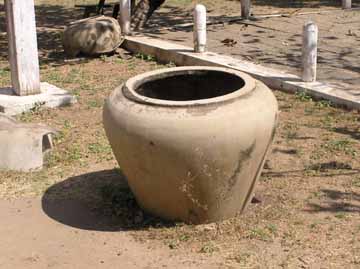

It took a painting by a survivor to explain the purposes. Human urine and feces were collected in the ammunition boxes and then emptied into the vat. When prisoners refused to confess their crimes, they were hung up with their hands behind their backs by ropes tied to the hooks, and then their heads were dipped into the vat.
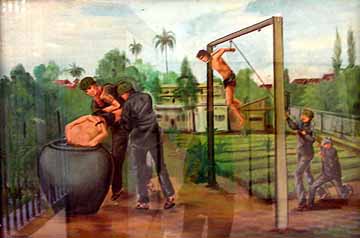
Here are some other implements of torture which are illustrated by paintings. If you look at the implements, they don't impress. Words of explanation are too abstract. It takes the paintings to make them concrete.
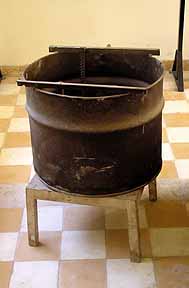
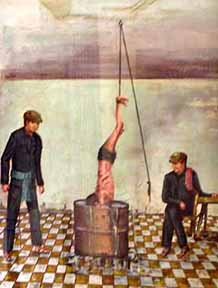
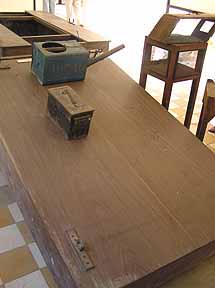
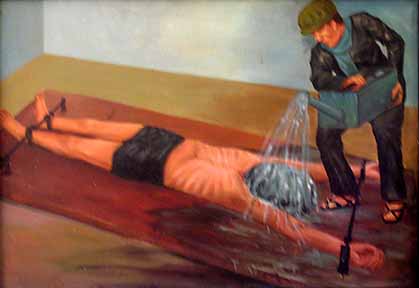
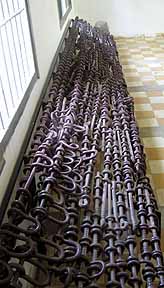
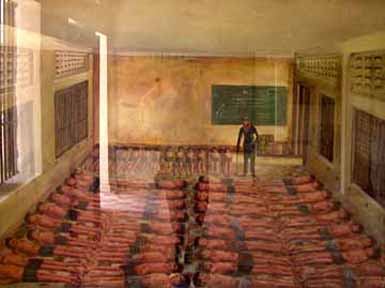
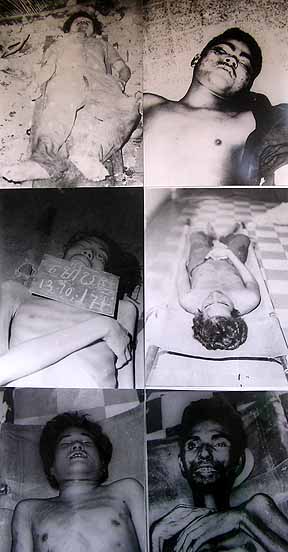
From David Chandler's Voices From S-21: Terror and History in Pol Pot's Secret Prison:
In the musuem, the eyes of the mounted mug shots, and especially those of the women and children, seem to follow me. Knowing as we do, and as they did not, that every one of them was facing death when the photographs were taken gives the photos an unnerving quality that is more affecting, for me at least, than the photographs of dead prisoners or the grisly portrayals after 1979 by the S-21 survivor, Vann Nath, that are also included in the display.
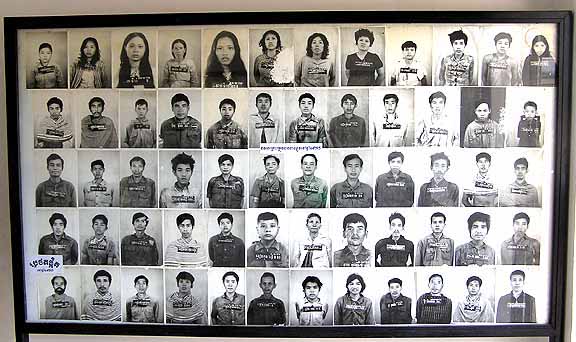
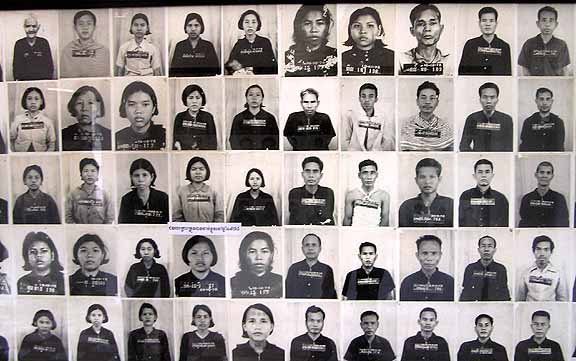
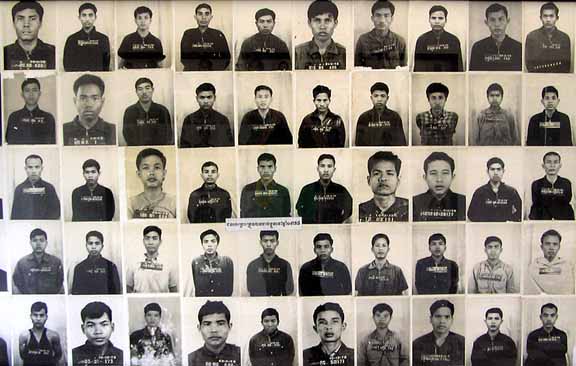
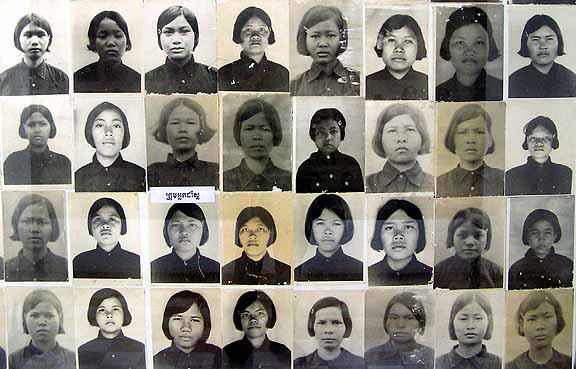
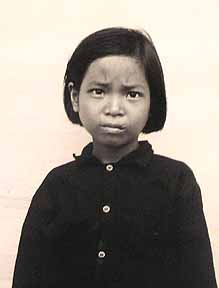

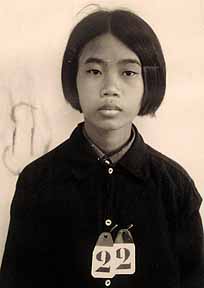
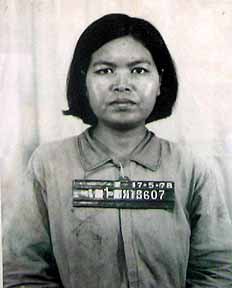
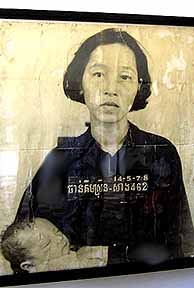
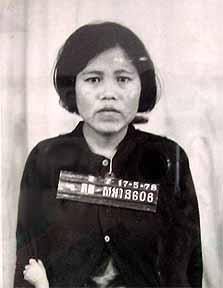
[I wanted to say something of my own at this point, but I have spent an hour looking at these photos, writing stuff and then deleting it immediately. Being maudlin is just not my style, so you're on your own here. What could you say to these people?]
Until recently, there was an exhibit of a map of Cambodia built from skulls and bones found at the killing fields. Based upon a request from the Cambodian human rights commission, this exhibit has been dissembled and the skulls are kept in a shelf out of respect to these identified dead persons. Today, only this large photograph is shown at this museum.
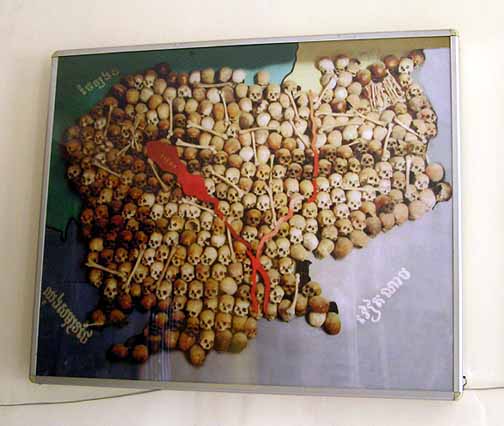
Why a skull-based map of Cambodia? Because the killings were not restricted solely to Phnom Penh, but occurred all over the country and just about every family lost someone somewhere sometime.
From David P. Chandler's Brother Number One: Pol Pot:
The mayhem that Democratic Kampuchea inflicted on its people led the French author Jean Lacouture to coin the word autogenocide -- to differentiate events in Cambodia from previous pogroms, holocausts, purges and vendettas. Lacouture's horror, if not the word he coined, was justified by the facts. In less than four years, more than one million Cambodians, or one in seven, probably died from malnutritiion, overwork, and misdiagnosed or mistreated illness. At least one hundred thousand, and probably more, were executed for crimes against the state.
At Tuol Sleng alone, the number of prisoners by year was as follows:
1975: 154 prisoners
1976: 2,250 prisoners
1977: 2,330 prisoners
1978: 5,765 prisoners
These figures, totaling 10,499 do not include an estimated 2,000 children. There are only seven known survivors.
From David Chandler's Voices From S-21: Terror and History in Pol Pot's Secret Prison:
The Yugoslav writer Milovan Djilas has observed that "the way prisons are run and their inmates are treated gives a faithful picture of society, especially of the ideas and methods of those who dominate the society" - a remark that seems particularly appropriate to S-21 and Democratic Kampuchea.
Who was behind this madness? There was the man known as Brother Number One: Pol Pot.
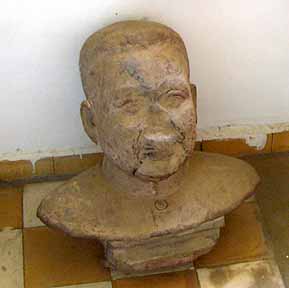
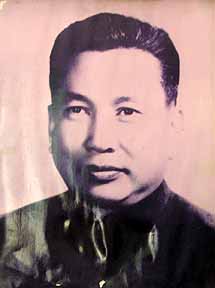
From David Chandler's Voices From S-21: Terror and History in Pol Pot's Secret Prison:
In 1997, when questioned by the journalist Nate Thayer, Pol Pot denied any knowledge of "Tuol Sleng," hinting that the museum and its archive were Vietnamese concoctions. "I was at the top," he said:
I made only big decisions on big issues. I want to tell you -- Tuol Sleng was a Vietnamese exhibition. A journalist wrote that. People talk about Tuol Sleng, Tuol Sleng, Tuol Sleng ... When I first heard about Tuol Sleng, it was on the Voice of America. I listened twice.
...
"As you know," he [Thayer] said, "most of the world thinks that you're responsible for the deaths of hundreds of thousands of innocent Cambodians who didn't deserve to suffer." Pol Pot replied: "I'm going to reply. I'm going to tell you clearly. I would like to tell you that I came to carry out the struggle, not to kill people. Even now, and you can look at me, am I a savage person? My conscience is clear."
Thayer pressed on, asking Pol Pot to acknowledge that he had "made very serious mistakes" during his time in power. Pol Pot replied deftly, in a schoolmasterish fashion: "There are two sides to it, as I told you. There's what we did wrong, and what we did right. The mistake is that we did some things against the people ... but the other side, as I told you, is that without our struggle there would be no Cambodia right now."
...
"I want you to know," he said, "that everything that I did, I did for my country."
...
Speaking to a Khmer reporter from Radio Free Asia on April 17 [1998], Ta Mok delivered a more brutal epitaph. "Pol Pol has died," he said, "like a ripe papaya. No one killed him, no one poisoned him. Now he's finished, he has no power, he has no rights, he is now no more than cow shit. Cow shit is more important than him. We can use it for fertilizer."
I remember the first time I saw the killing fields at Choeung Ek: pits with rainwater in them, scraps of cloth and concretions of bone in the exposed earth. In one mass grave swam fat, unwholesome frogs. A child was catching them; his family was going to eat them. When I try to conceptualize Cambodia's suffering, that sight -- repulsive to me, presumably ordinary to the boy -- reminds me equally of the presence of the murdered and the sad expedients of the living. Pol Pot and his Khmer Rouge had been expelled by the Vietnamese a dozen years before, but their influence remained everywhere. During that first visit of mine, in 1991, one could stand in the middle of the widest boulevard in Phnom Penh at night and count stars. Electricity was the loud, weak and temporary product of generators. In place of the vehicle fumes of a couple of years later, one smelled sandalwood. Everything seemed as broken as the bones at Choeung Ek. Wasn't all this of a piece? Obviously it was the Khmer Rouge's fault that children were catching dinner in mass graves.
Philip Short's new biography of Pol Pot proves me wrong. It quotes an old member of the Khmer Rouge who remembers being a child and finding decapitated heads in fishing ponds. ''It didn't bother us. . . . We'd yank them out by the hair, and throw them aside.'' That was in 1949, before there was a Khmer Rouge. Pol Pot was then an undistinguished student en route to accept a radio technology scholarship in Paris.
There are two ways to distort the enduring presence of atrocity in Cambodia. One is to dwell, as I tend to do, on victims. Short, a British journalist who previously wrote a well-regarded biography of Mao, tends to dwell on perpetrators. In place of the boy at Choeung Ek, he brings to our notice a woman named Khoun Sophal, whose husband, a government minister, had taken a 16-year-old mistress. Her countermeasure: three liters of nitric acid. ''Scores of teenage Cambodian girls are disfigured and in many cases blinded in acid attacks by rich men's wives,'' Short writes. ''The parallel with Khmer Rouge atrocities is striking. One way to try to understand why the Cambodian Communists acted as they did is to enter into the mind of a well-educated, intelligent woman'' like Khoun Sophal.
This 1999 incident evidently haunts Short as much as the sight of the frog-fishing boy does me. In his afterword, which bluntly states, ''The present Cambodian government is rotten,'' he brings up the Khoun Sophal sisterhood as exemplars of ''a culture of impunity. . . . In such circumstances, trying the surviving Khmer Rouge leaders for past crimes offers an alibi for doing nothing about present ones.''
In other words, he seems to say, what Pol Pot did was hardly beyond the Cambodian ordinary. ''Every atrocity the Khmers Rouges ever committed, and many they did not, can be found depicted on the stone friezes of Angkor . . . or, in more recent times, in the conduct of the Issaraks,'' the anti-French insurgents who threw those heads into the ponds back in 1949.
Obviously, whether or not one accepts this interpretation of Cambodian history affects how one sees Pol Pot.
And who was Pol Pot? In 1996 I asked a Khmer Rouge defector and, through a translator, got this answer: ''He don't know. Pol Pot is just another word for Khmer Rouge. Maybe not a person. But if a person, Pol Pot always have a black uniform, and wear red fabric on head and wear shoes from rubber. But he never see.''
Nobody had seen him; everybody had heard his name. ''In the Pol Pot time,'' people would say, and the story that followed was always horrendous. A woman I loved told me how she'd had to watch her family's heads smashed in one by one; if she had wept, she would have been next. She blamed Pol Pot. A number of Cambodian slum dwellers and Thai dealers in illegally logged hardwood admired him; most abhorred him. His brother, Loth Suong, told me that Pol Pot had been a kindly child. He didn't consider himself Pol Pot's relative anymore. Until recently, nobody even agreed about whether he was still alive. (He died once and for all in 1998, at 73.) One might call him the Osama bin Laden of his epoch; but he was more invisible to our knowledge than that other bugbear. In David P. Chandler's excellent biography, ''Brother Number One'' (1992), there is an eerie photograph of Pol Pot applauding and smiling in a crowd. What do we know about him, except that he smiles? Oh, that smile of his! Short quotes his henchman, Ieng Sary: ''His face was always smooth. . . . Many people misunderstood that -- he would smile his unruffled smile, and then they would be taken away and executed.''
Short's book is ampler than Chandler's, and his footnotes contain evidence of an impressive diversity of sources, not to mention any number of thoughtful qualifications and interesting anecdotes. His text sparkles with shrewdly plausible inferences mortared into a compelling narrative. For instance, about the odd, yet in retrospect perfectly natural spectacle of the young Saloth Sar, who was not yet Pol Pot, lauding the Buddha as the first champion of democracy, Short comments: ''Like his choice of the pseudonym Khmer Daeum, it suggested a conscious desire to identify himself with an authentically Cambodian viewpoint rather than imported, Western ideas.'' If we fail to understand that desire, Pol Pot's anti-Vietnamese xenophobia and his expulsion of the urban populations will never make sense.
Were this biography a novel, I would apply the word ''verisimilitude'' to much of it, for Short's Pol Pot possesses a detailed reality whenever he appears. And why shouldn't he? We know more about him than we did when ''Brother Number One'' appeared. Short got the benefit of Nate Thayer's groundbreaking interview with the old murderer, not to mention eyewitness accounts of his remarriage, death and cremation. His account of Pol Pot's final two decades is of exceptional interest.
But my qualification that Pol Pot is vividly drawn whenever he appears remains unfortunately necessary. I wouldn't have wanted Short to cut any of his multipage summations of royalist Cambodia's domestic and foreign policies, Nixonian realpolitik during the Vietnam War or the politics of postwar Cambodia. But one may wish for more than the all-too-occasional paragraph or two in which Pol Pot takes a direct role. ''In September 1994,'' Short writes, ''the gentle old man who doted on his small daughter ordered the execution of three young backpackers''; such details do acquaint us with the monster, but there are not many of them. Our protagonist does get his biographical due in youth and old age, and fleetingly during his three years as the ruling despot of Democratic Kampuchea. But during the crucial two decades between the mid-1950's and his secret entry into a subjugated Phnom Penh, he remains ''just another word for Khmer Rouge. Maybe not a person.''
Could it be that because Pol Pot identified himself so thoroughly with his revolution, there was no him for us to know? Isaac Deutscher's biography of Stalin, and Alan Bullock's of Hitler, manage to ''bring alive'' tyrants whose personal lives were banal. Perhaps the problem is that Pol Pot was mediocre in almost every sphere: a failed technical student, an uninspired military leader who wasted the lives of his troops in badly planned offensives and ignored emergencies, a misguided ruler. In sum, Pol Pot would exert little claim on our attention were it not for the fact that millions died through his cruelty and incompetence. In ''Brother Number One,'' Chandler admits defeat at the outset: ''I was able to build up a consistent, but rather two-dimensional picture. . . . As a person, he defies analysis.''
When Short doesn't give us Pol Pot, what do we get? First and foremost, a highly readable summary of a half-century of Cambodian history. His characterization of Prince Sihanouk, the man for whom the word ''mercurial'' was invented, is vivid and at times based on personal observation. He is excellent at coining pithy summations of political motives that ring humanly true. For instance, shortly after World War II ''the Cambodians embraced Marxism not for theoretical insights, but to learn how to get rid of the French and to transform a feudal society which colonialism had left largely intact.'' Indeed, in my own interviews with Khmer Rouge I have been struck by how few of them knew anything about Marx. Short is correct: more than we would like to think, theirs was an indigenous movement. Most of us would like to believe the worst of the Khmer Rouge, but Short doesn't always let us. He takes pains to show that between 1970, when Sihanouk was overthrown by the American puppet Lon Nol, and 1972, when Pol Pot demanded that the revolution be sped up, the Khmer Rouge not only respected the autonomy of most peasants in their control, but performed such active kindnesses as sending help to bring in the harvest.
He is especially good at conveying the incremental buildup of harshness in the revolution. Here it differed from its Russian analogue, where, as Trotsky famously put it, ''something snapped in the heart of the revolution'' after the assassination attempt on Lenin in 1918. In Cambodia there does not seem to have been a triggering event. One of the Khmer Rouge's first roundups, which occurred the year before they conquered Phnom Penh, netted their own Communist compatriots who'd sojourned in Vietnam. A detention camp was built for these victims ''with Khmer bodies and Vietnamese minds,'' most of whom were then liquidated over a period of years. Meanwhile, strangers in the ''liberated zone'' had begun being treated as spies, and peasants were killing the educated, although this was not yet Pol Pot's stipulated policy. These events, to which Chandler's biography lacked the space to do justice, Short narrates with clarity and detachment, coincidentally underscoring his thesis of the normality of Cambodian atrocities as footnotes to the stone friezes of Angkor. Meanwhile he renders Pol Pot's crimes less aberrant, less simply sadistic, by explicating their rational basis. For instance, here is Brother Number One's directive concerning the Cham insurgents (they disliked being ordered to abandon their cultural distinctions): ''The leaders must be tortured fiercely in order that we may obtain a complete understanding of their organization.''
Short has much of value to say about the organization of rural life in Cambodia and how that sometimes informed, and sometimes defeated, Pol Pot's expectations. He is equally adept at explicating the Khmer Rouge grand strategy, which seesawed between Vietnam and China, all the while retaining Prince Sihanouk as an improbable figurehead. He gives reasonable due to the progressive destabilization of Cambodia caused by the Americans and the North Vietnamese in the 70's, a tale told first and best in William Shawcross's ''Sideshow: Kissinger, Nixon and the Destruction of Cambodia.'' Short discounts Shawcross's opinion that the Khmer Rouge's radicalization into cruelty had much to do with the carnage and terror caused by America's secret bombing campaign. He prefers to believe that Pol Pot and his ilk would have been atrocious anyway. So do I.
At times, Short's summations of motives decay into snap judgments. At one point, he claims that the Khmer Rouge killed captured government troops without mercy because ''in the Confucian cultures of China and Vietnam, men are . . . always capable of being reformed,'' for instance into good Communists; ''in Khmer culture they are not.'' But 40 pages earlier, while laying out what made the Cambodian style of Communist revolution different from all others, Short invokes Theravada Buddhism to obtain the following result: ''The idea that 'proletarian consciousness' could be forged, independent of a person's class origins or economic status, became the central pillar of Khmer communism.'' If it was really a ''central pillar,'' surely royalist prisoners could have been indoctrinated instead of exterminated.
There are many such preconceived moments, as when Short informs us of the parallel lives Cambodians supposedly live, one grounded in reason and the other ''mired in superstition,'' or glibly declares that ''Cambodians assert their identity by means of dichotomies: they are in opposition to what they are not.'' There is a whiff of hubris in these categorizations. They may be correct for all I know, but where's the proof? And when he comes to the three hellish years of Pol Pot's rule, he offers as one of the reasons for creating ''a slave state, the first in modern times,'' the following unpleasant assertion: ''Pol . . . faced a genuine and all but insurmountable problem, which had defeated the French, defeated Sihanouk, and has defeated every Cambodian government since. The problem was: how to make Khmers work. Putting it in those terms will raise hackles. But the issue is too important to be brushed aside with comforting platitudes.'' Short does not quite say that laziness is a national Cambodian characteristic, but he comes close.
I do grant that Cambodians frequently work more slowly, and with smaller material ambition, than do many Americans, Germans and Japanese -- but I would never characterize that as an exclusively Cambodian phenomenon; and I would hold climate, malaria and intestinal parasites responsible. When I go to, say, Burma, I eat less and less; my strength declines; lassitude decreases my resolve while increasing my patience; then the fever or the diarrhea starts. Short himself mentions Pol Pot's incapacitating bouts of malaria. The book's rationalization of the Khmer Rouge program of forced labor, no matter how it's hedged, makes me uneasy. More specifically, it makes me look apprehensively back upon Short's near equation of Khmer Rouge atrocities with acid attacks carried out by jealous middle-aged wives. I don't entirely disagree, but I worry that Pol Pot's crimes might thereby be trivialized.
Most likely Short's opinionated peculiarities are well-meaning attempts to add nuance to our indictment of Pol Pot. Did he commit genocide? Short argues persuasively that he did not. His crimes against humanity were for the purposes of enslavement, not extermination. So what? As Short writes: ''The U.S. Army's conduct in Iraq (as earlier in Vietnam) merely lengthens the catalog of inhumanities perpetrated in the service of democratic ideals. The United States, whose allergy to supranational justice is so highly developed that it rejects it out of hand for American citizens,'' asserts that ''international tribunals should be limited to exceptional crimes such as genocide and not allowed to spill over into areas where the actions of 'normal' governments might come under scrutiny.'' In the wake of My Lai and Abu Ghraib, this point is sadly well taken. Short is no apologist for the Khmer Rouge, but an honest researcher who tries, if occasionally too zealously, to keep everything in perspective.
No doubt some people will be offended by this book, not only for its indiscretions, but also for its restraint. Wasn't Pol Pot a monster pure and simple? How dare Short imply otherwise! This attitude, understandable though it is, hinders our apprehension of reality. The truth is that even now you can find poor people in Cambodia who -- no matter that they lost relatives in the Pol Pot time -- wish for the return of the Khmer Rouge.